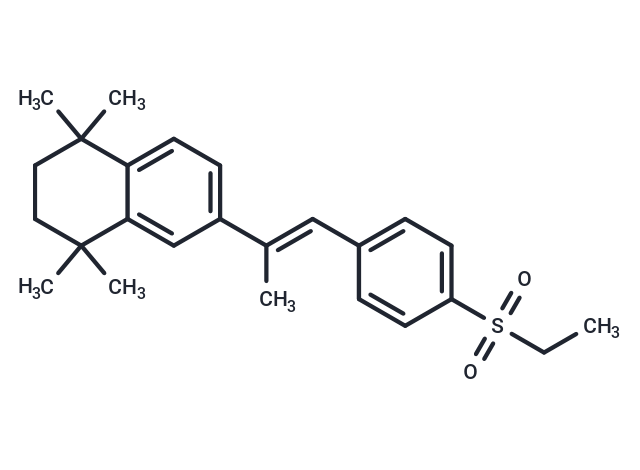Shopping Cart
- Remove All
 Your shopping cart is currently empty
Your shopping cart is currently empty

Etarotene (Arotinoid ethyl sulphone) is an ethylsulfonyl derivative of aloe acid with differentiation-inducing and potentially antitumor activity.Etarotene is a collagenase inhibitor and can be used to study psoriasis.

| Pack Size | Price | Availability | Quantity |
|---|---|---|---|
| 1 mg | $155 | In Stock | |
| 5 mg | $385 | In Stock | |
| 10 mg | $548 | In Stock | |
| 25 mg | $822 | In Stock |
| Description | Etarotene (Arotinoid ethyl sulphone) is an ethylsulfonyl derivative of aloe acid with differentiation-inducing and potentially antitumor activity.Etarotene is a collagenase inhibitor and can be used to study psoriasis. |
| In vivo | Etarotene (6 mg/kg; oral; 1 and 2 weeks; rats) show weight loss, alopecia, erythema, desquamation of the skin, and alterations of the skeletal system. The present demonstration that the arotinoid ethyl sulfone Etarotene was devoid of bone toxicity constitutes major progress in the pharmacologic development of retinoids with a better balance between therapeutic and adverse effects.[5] |
| Alias | RO15-1570, RO-15-1570, RO 15-1570, Arotinoid ethyl sulphone |
| Molecular Weight | 396.59 |
| Formula | C25H32O2S |
| Cas No. | 87719-32-2 |
| Smiles | CC1(C)C=2C(C(C)(C)CC1)=CC=C(\C(=C\C3=CC=C(S(CC)(=O)=O)C=C3)\C)C2 |
| Relative Density. | 1.059 g/cm3 (Predicted) |
| Storage | Powder: -20°C for 3 years | In solvent: -80°C for 1 year | Shipping with blue ice. |

Copyright © 2015-2025 TargetMol Chemicals Inc. All Rights Reserved.